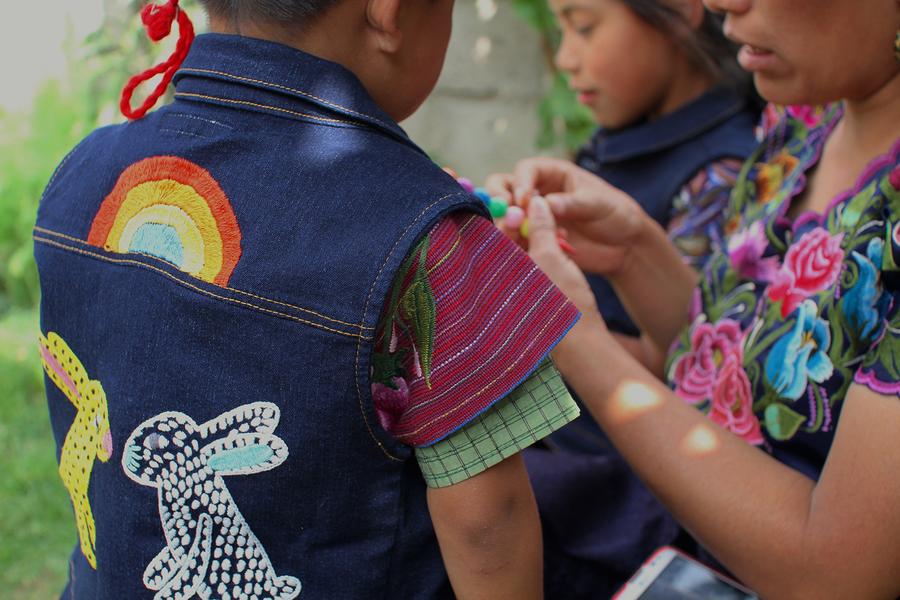When 31-year-old Monserrat Dominguez reminisces about her childhood, she instantly finds herself riding alongside her father on the Mexican highway. She recalls the wonder and awe she felt as he introduced her to the people, culture and nature of Mexico’s rural towns.
Far from the busy streets of Mexico City, Dominguez felt a pride and connection to her heritage that grew stronger with each trip. As an adult, she wanted to find a way for the next generation of children to connect to Mexican history and culture, particularly its indigenous roots.
She wasn’t alone. When 32-year-old Annia Ezquerro became a mother, she had a vision of how she wanted to dress her children. She wanted clothes and decorations that expressed the pride she felt in her Mexican heritage. But these products were not available in the infant market. She set out to change that.
“The ideal combination was to create handcrafted pieces loaded with [the] traditions of our country, that were comfortable and functional for kids and parents,” she said. “Together, Monse and I came up with all these ideas that resulted in the identity of the brand.”
They launched Korimi Kids in late 2015, and it has since grown into a successful small business owned and operated by women. Ninety percent of employees at Korimi are female.
Ezquerro is the creative brains behind the effort, while Dominguez ensures the brand stays humble and true to its roots. The owners chose the name Korimi because it signifies ‘rainbow’ in the indigenous language of Rarámuri.
“We want to be a rainbow of colors, of different communities and artisans from all over the country with diverse and different techniques,” Dominguez said.
The duo met at Harper’s Bazaar Latin America, where Dominguez worked as a fashion assistant and Ezquerro worked as a fashion coordinator. A Cuernavaca, Morelos native, Ezquerro studied textile design and fashion and began working as a fashion stylist for magazines, publicity and music videos in 2007. Dominguez specialized in business administration and earned a diploma in visual merchandising, which led to her work in fashion beginning in 2010.
Their similar ages and aspirations paved the way for a blossoming friendship, which led to the launch of their company. Ezquerro aims teach her daughter she can be independent and follow her dreams despite naysayers.

“In Mexico, we live in a macho and conservative society in which women are taught to have a family and care for their children and their spouse,” Ezquerro said. “Many of the artisans with whom we work have to stop working when they marry even when they need the money.”
Korimi Kids gives these artisan women a financial stream and sense of security, as well as the experience to develop self-confidence in their creative vision. Dominguez and Ezquerro make the illustrations, which are then hand-embroidered by women in Chiapas and Estado de Mexico. They work with the non-profit Kip Tik (formerly Aid to Artisans) in Chiapas, which has established relationships and payment methods with artisans, who set the prices for their own work.

“We live to work together,” Ezquerro said. “We understand the needs of women and support them.”
Fashion items for sale include shoes, vests, accessories and onesies. Home décor features cushions, pennants and throws. Products are inspired by legends and stories that are staples of Mexican culture.
Cushion and denim vests available as part of Korimi Kid’s first collection is inspired by the moon rabbit of Aztec mythology.
“It represents friendship and the power of caring for others,” said Dominguez. “We want to express to our kids to be conscious about the needs of others.”

Other powerful and legendary animals in Mexican folklore include the jaguar and deer.
“We feel most kids nowadays don’t know about Mexico’s powerful animals and we have this tremendous opportunity to incorporate these legends into their imaginations,” Dominguez said.
The women see their project not just as a way to financially support artisans, but also to support the evolution of their creative expression. Angelina of Chenalhó, Chiapas is one of the embroidery team leaders who found new inspiration when she realized she would be working with different fabric.
“You could see through her eyes all this love, passion and creativity,” Ezquerro said. “It makes us feel like we’re on track to make them feel worthy not only because of her work but because she is developing creative thinking and a way to express herself.”
Paty is a seamstress from Estado de México with plenty of experience leading workshops for artisans in the community.

“She found it difficult to get a job because of her age and her work demands prohibited her from nursing her sick mom,” Ezquerro said. “Korimi is a way for her to feel productive not only financially, but creatively and personally. We really want to transmit in our products that each piece has history of these women who are sharing love, creativity and passion.”
Korimi Kids plans to offer workshops to help the women nourish their creativity while developing a business mindset. The idea is for the women to eventually develop their own products in their own communities, which they can rely on as continued source of income.
“This knowledge comes from grandmothers and mothers,” Dominguez said. “It’s really touching that we can conserve these emotions and this knowledge in a product. We realize after these products are finished they have the potential to last forever making them living memories and living history.”







